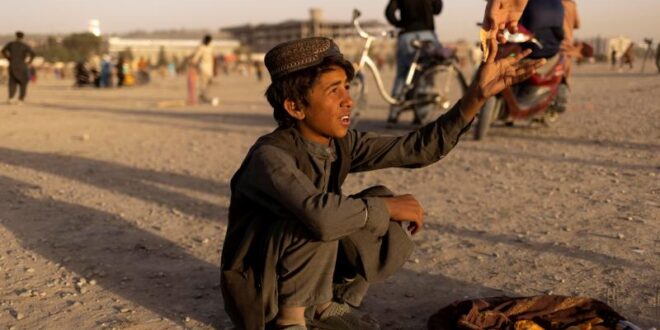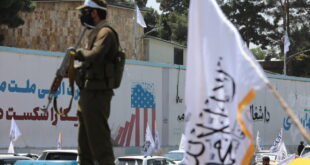Why the United States and Its Allies Must Act Now to Prevent a Humanitarian Disaster
On December 1, a United Nations official said that Afghanistan may be facing the most rapid economic collapse in modern history. Since the Taliban takeover in late August, government revenues have all but disappeared and the country’s cash-based economy has shrunk at dizzying rates. The World Food Program estimates that up to 23 million Afghans—more than half the population—may not have enough to eat by the end of the year. Public-sector workers have not been paid in months, and three million children under the age of five face acute malnutrition, an almost unfathomable number. As winter begins, Afghanistan is on the brink of a humanitarian catastrophe.
The challenge is providing relief on the necessary scale to meet the unprecedented needs of the Afghan people. The United States and its allies rightly seek to deny the Taliban government any legitimacy or funding until it provides guarantees for the rights of women, girls, and minorities and unequivocally cuts its ties to international terrorism. The U.S. Treasury, international donors, and organizations have frozen billions of dollars of Afghan assets and seek to channel humanitarian aid through UN relief agencies and the nongovernmental organizations (NGOs) still operating, with difficulty, inside the country. Meanwhile, despite the growing crisis, the Taliban have shown little sign of changing their behavior.
Confronted with this impasse, Western governments and international organizations are being forced to reconsider how they can deliver assistance more effectively. Doing so requires broadening the definition of basic humanitarian activities that are permitted under the sanctions regime and addressing the all-consuming question of cash liquidity for emergency operations. The time for decision is now: the window is closing for millions of Afghans as the humanitarian emergency on the ground intensifies by the day.
A DIFFERENT KIND OF CRISIS
In contrast to the Taliban takeover, Afghanistan’s humanitarian situation has unfolded with far less media attention, in part because there are not millions of refugees fleeing across the country’s borders; there is no raging civil war; the country on the surface appears to be relatively peaceful; and some members of the former political elite are still inside the country.
The view from the ground, however, is very different. Even before Kabul fell on August 15, the Afghan economy was precarious. Under the democratically elected government, Western governments and aid agencies provided billions of dollars in humanitarian and development assistance, funds that amounted to more than 40 percent of the country’s GDP and 75 percent of public spending. Yet even with this support, per capita income remained one of the very lowest in the world, declining from $642 in 2012 to $509 in 2020. Then, large parts of the country were stricken by one of the worst droughts in years as well as deteriorating security, and, by mid-2021, almost half the population, or 18.4 million people, required humanitarian assistance. The UNDP is now estimating annual per capita income could drop further to a disastrous $350 by next year, which would place Afghanistan at or near the bottom of the World Bank low-income country rankings.
In the three months since the Taliban took power, these problems have dramatically escalated. Millions more now require humanitarian assistance. And with international aid flows cut off and the banking system largely frozen, the International Monetary Fund estimates that the economy will shrink by as much as 30 percent by the end of the year. The financial collapse is compounded by a Taliban government that seems to have no coherent plan for running the economy and has devoted much of its sparse revenues to paying Taliban fighters, as a recent report by the Afghanistan Analysts Network has suggested. At the same time, the regime has been unwilling to make concessions on human rights and security to receive international assistance. Afghanistan’s financial links to the world have been severed, almost literally from one day to the next.
The effects on the population have already been stark. Noting that “food security has all but collapsed,” a recent World Food Program report finds that millions of Afghans will have to choose this winter between migration or starvation. Across Afghanistan, there is a high risk of famine, both in cities and in the countryside. In large urban centers such as Kabul, and in provincial capitals, hundreds of thousands of civil servants, teachers, and health workers are no longer being paid, leaving their families with little or no basic income; in rural areas, drought, the lack of cash and markets, and now the onset of winter threaten disaster.
MAKING ROOM FOR RELIEF
In responding to the crisis, Western governments and international organizations are faced with difficult choices. Any expanded assistance to Afghanistan risks the charge that it is consolidating the Taliban in power and weakening leverage to influence their behavior, thereby provoking a likely political backlash in the United States and elsewhere. There is also the risk of inadvertent sanctions violations as international organizations provide emergency relief inside Afghanistan.
Of course, diplomatic and political preconditions on engagement with the Taliban can and should remain in effect. But it should also be possible for the United States and its international partners to augment their emergency response to help ordinary Afghans without making concessions to Afghanistan’s new rulers. The pledges already made by donors to UN agencies and NGOs are important to ensuring humanitarian operations can proceed. Given the outsize dimensions of the crisis, however, these organizations will need clearer authorization and guidance from the international community if they are to respond quickly and effectively to the country’s urgent and multiple needs.
To address these challenges, the existing international framework for dealing with the Taliban needs to be adjusted. UN Security Council Resolution 1988, which established the Afghan sanctions regime, was passed in 2011, but built on over a decade of measures targeting the Taliban and their finances. In current circumstances, with the Taliban now in control of the country, the UN could make it clearer that UNSC 1988, although still in effect, does not apply to humanitarian work.
Discussions at the Security Council are currently underway, and the creation of a humanitarian exception to the 1988 sanctions regime may soon emerge. But to be effective, it must allow relief organizations to address the collapse of the country’s health services and the Taliban’s systematic restrictions on female education and women in the workforce, which have added another terrible dimension to the crisis. Such action, however, would require these organizations to deal with the Taliban regime in these areas. To reach the girls and women who are most vulnerable in the current crisis, there must be room for international aid efforts to operate in the spheres that affect them most.
Some donors, such as the World Bank, Germany, and the Netherlands, have suggested waivers that would allow workers in the health sector to be paid, with the World Bank reportedly considering releasing up to $500 million in funding. The lack of salaries for medical personnel has deeply hampered the most basic health services, a problem that has had a particularly direct impact on vulnerable children.
In such a new resolution, the “carve out” language could authorize UN agencies and NGOs to work in these defined sectors as well as providing more traditional humanitarian relief. Without such specified areas in which to operate, relief organizations and the World Bank will be at continual risk of the application of sanctions to their activities in Afghanistan. As the humanitarian strategist and former senior U.S. official Sue Eckert proposed in her recent testimony to the U.S. Senate Banking Committee, the Department of the Treasury also has tools—General License Nos. 14 and 15—that could provide broader authorizations for humanitarian operations in this situation. The Treasury Department has previously used this approach in Yemen, Ethiopia, and Venezuela, defining humanitarian relief to include working in multiple sectors such as education and the provision of health services.
CREATING CASH FLOWS
But it is not enough to broaden the scope of emergency relief. Getting funds into Afghanistan has become extremely challenging in part because financial institutions themselves are fearful of running afoul of sanctions. Humanitarian operations require a regular cash flow to sustain themselves: to pay for transport; to pay for shelter; to pay the salaries of those who work with relief agencies or in the education and health-care sectors; to pay for the establishment of distribution centers; to pay for fuel and medicine. Yet in the current situation, it has been tough for aid operations to access and distribute such funds.
The challenge remains daunting. Afghanistan’s $9 billion in reserves will and should remain frozen for the foreseeable future. Transferring any currency into the country faces numerous difficulties, and engaging with what remains of the private banking system is highly risky for correspondent banks. And flying in U.S. currency is neither a safe nor a sustainable option.
Cash could be brought in through Afghanistan’s private sector.
There are, however, short-term options that could promote emergency assistance for humanitarian relief through the winter. Safe payment mechanisms to ensure the transfer of funds for humanitarian operations are necessary. Among recent proposals to address the cash-flow problem, those made by former World Bank economist William Byrd and former Treasury official Alex Zerden stand out. They have both suggested, for example, working through private banks that still operate in Afghanistan.
Although not all their proposals may be feasible, they suggest creative approaches to bring funds into the country by working through the private sector banks and companies that still operate in Afghanistan, introducing Afghan banknotes, using digital transfers to individual households, and facilitating the commercial imports of essential goods under the Treasury Department’s General License No. 15. The Afghan-American Chamber of Commerce has also proposed that the United States and the International Monetary Fund unfreeze $1 billion in assets belonging to Afghan private citizens.
Whichever approach is taken, the United States and other donors must act quickly. In late November, the UN warned that the breadth of the Afghan crisis—the lack of currency and inability to access private accounts, take out loans, or pay for the imports that the economy depends on and that were previously financed by external aid money—will lead to a complete collapse of the country’s financial system within months.
A CHANCE TO ACT—BEFORE IT IS TOO LATE
Given the deep and justified concerns about the Taliban deriving benefit from international assistance, expanding the scope for assistance will not be easy. The Taliban’s long—and recent—record of repressive actions, their affiliation with international terrorist groups, and the presence of sanctioned terrorists in their government cannot be waved away. For the United States and its allies, which only recently evacuated their troops, embassies, and citizens from Kabul, there is a strong sense that a humanitarian response to Afghanistan’s crisis must coincide with corresponding pressure on the Taliban.
Without immediate action, however, there is the risk of a humanitarian disaster of historic proportions by mid-winter. Such an outcome would not only cause great suffering to the Afghan people but also heighten the contradictions of the 20-year international engagement in Afghanistan. We should not wait for that disaster to respond to the challenges that are evident now. The United States and its allies cannot undo the failures that led to the fall of Kabul in August. But they can ensure that ordinary Afghans know we will not turn our backs on them at a time of extraordinary need.
 Eurasia Press & News
Eurasia Press & News



